Sterling silver is a highly desirable metal. Besides the beauty characteristic of silver, this precious metal can last a lifetime if maintained well.Pure silver is softer than sterling silver, so it’s fairly easy to differentiate between them. But how can you distinguish between genuine and fake sterling silver? Or how can you know for sure that the beautiful tea set is a solid sterling silver piece?
It’s by the identification markings and numbers on it. Sterling silver items have a stamp imprinted on them. Read on to learn more about sterling silver identification markings and numbers.
Table of Contents
What Year Did They Start Marking Sterling Silver?
As early as the 1300s, there were varying systems of hallmarking silver. Different manufacturers had their marks with varying details. It proved confusing, and companies clashed when some markings appeared similar.
In 1907, the first standard marking was introduced.
From then on, manufacturers were required by the law to imprint the stamp to indicate high quality.
The standard marking on sterling silver and other metals has been of great help. The previous grading system had random details, and the metal’s purity was often unclear.
Since the introduction of the standard sterling silver mark, you can now easily tell how pure your silver item is.
What Do Numbers Mean on Silver?
In many countries, commercial silver has some markings that consist of some numbers. These numbers are engraved on the metal.
The numbers on silver reveal the purity of the metal. The purity level is measured in parts per 1,000. The higher the number, the more pure the metal is. For example, 925 indicates that the piece is at least 92.5% silver.
Below are the different numbers you’ll find on silver and what these digits denote:
1. 925

925 means the metal is sterling silver. Sterling silver is 92.5% silver and 7.5% an alloy of copper or nickel.
Thanks to the alloy, sterling silver is harder than fine silver but softer than many metals. The alloy it contains is also the reason it’s very durable. It can last a lifetime if well-maintained.
Sterling silver also has an attractive color and luster, again due to its alloys. Its bright and shiny color is what we attribute to silver. It explains why sterling silver is the most common silver type. It’s also more pocket-friendly than fine silver.
However, this silver tarnishes. But thankfully, it’s easy to polish, and there’s an array of polishing products available that you can use to leave it looking good as new.
2. 999
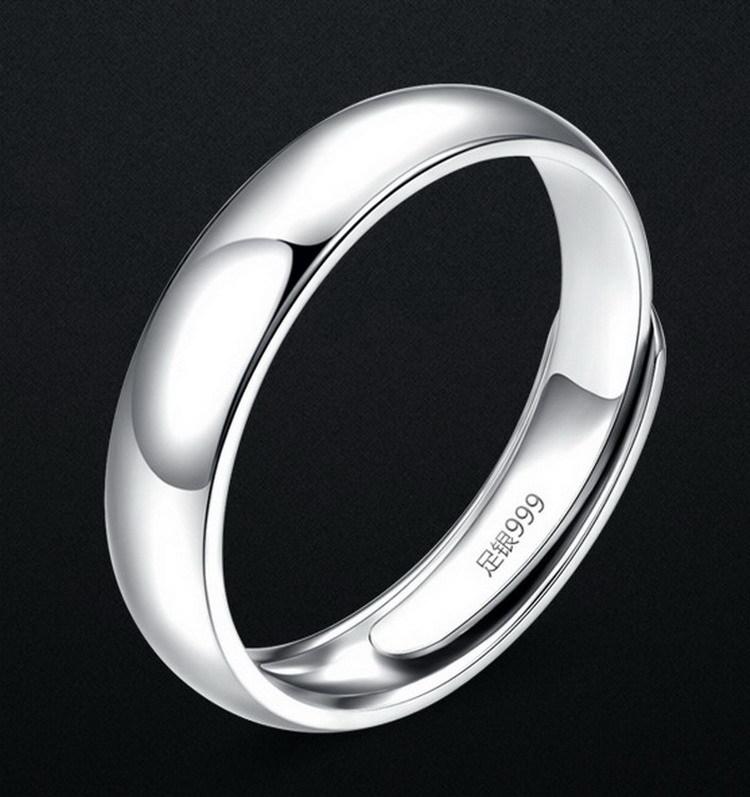
The number 999 stands for fine silver. It indicates that the metal is 99.9% silver, and as the number suggests, this silver is the closest to the pure element silver. The 0.1% is trace elements of an insignificant quantity.
You might be wondering why sterling silver, with its lower percentage of silver, is more popular than fine silver.
Fine silver is a little grayer and not as bright as sterling silver. It’s also soft and will scratch or dent pretty easily.
But this precious metal has its advantages too. It does not tarnish. And as far as making products out of it, you don’t have to solder it to fuse.
3. 900
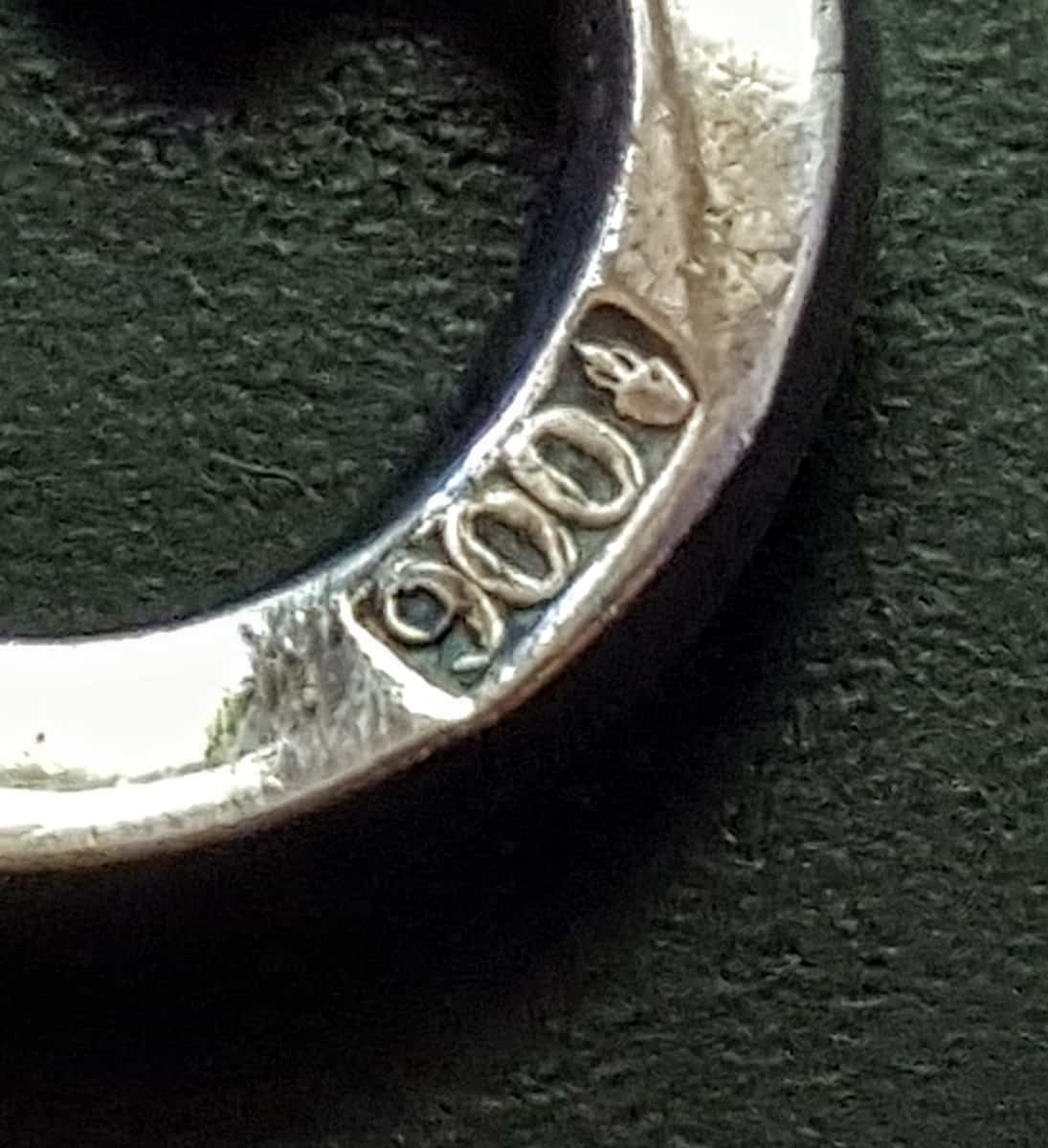
The number 900 stands for coin silver. It’s 90% silver and 10% copper.
This metal is not so common today. But back in the day, silversmiths melted scrap coin metal and used it to make items.
If you’re wondering how this liver acquired the name coin silver, it’s because, at the time, many countries made their coins from silver.
Today, coins are no longer made from precious metal. Instead, what’s used is inexpensive but durable metals.
You can still find collectible coins. These have a higher silver content and bear a stamp. Any coin silver items available in the market today are antique pieces.
4. 925 SF
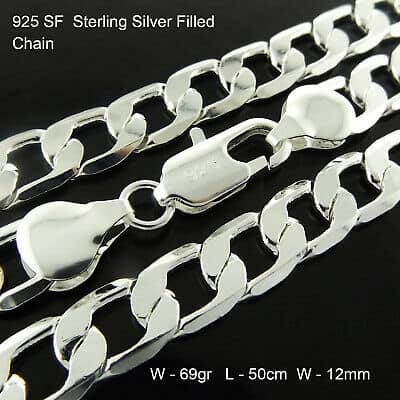
This highly misleading number means silver=filled. It’s a layered metal in which 5% or 10% of it is sterling silver fused in a brass core.
Silver-filled metal has not been around long. During the recession, the price of silver skyrocketed, resulting in its introduction.
As you can expect, silver-filled metal tarnishes due to the sterling silver layer on its surface. And as far as soldering, only a professional can do it using special precision tools.
It’s important to note that there’s no federally-approved quality mark for this metal, although it’s often stamped .925 SF.
5. 800
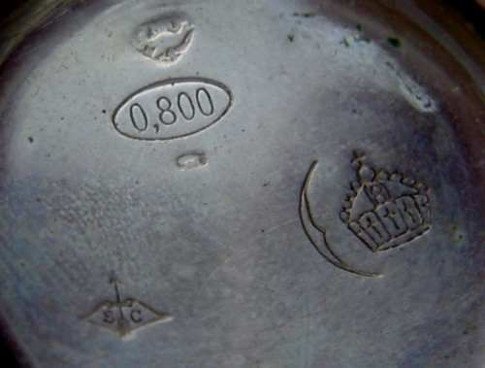
This number stands for European silver, also known as Continental silver. It means the metal is 80% silver. However, the marking on this metal can also be 825 or 850, meaning it comprises 82.5% or 85% silver, respectively.
6. 958
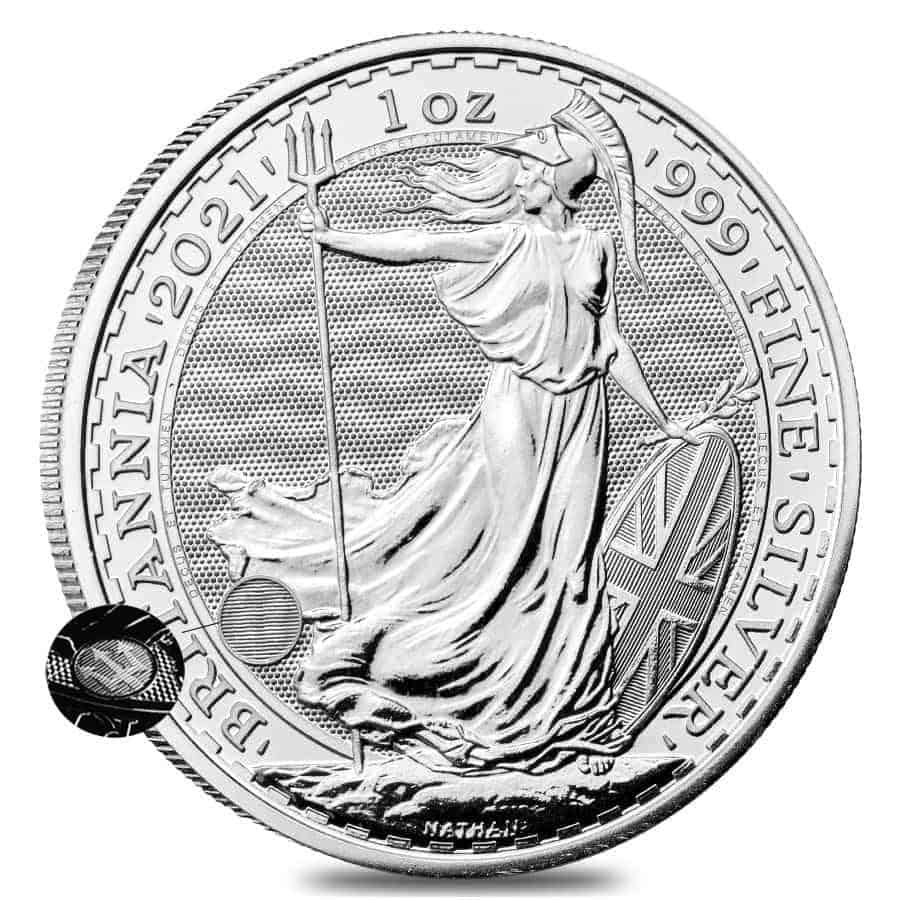
The number 958 symbolizes Britannia silver, although 950 is what’s often used. Britannia silver contains 95% silver.
Although the metal qualifies as a Sterling silver, it contains a higher amount of silver, making it softer.
What Are the 5 Standard Silver Marks?
Hallmarks contain distinctive historic symbols, which vary from country to country.
It’s not uncommon to find pieces with elaborate markings of symbols or alphabets. Sometimes, though, these markings may merely refer to some silver coating, not the intended purpose of enabling you to determine the item’s purity.
Since the first British silver hallmark was introduced, trading precious metals without a stamp have been illegal.
UK and Ireland
The UK (Scotland, England, Wales, and Northern Ireland) and Ireland use the same hallmarking system, and it’s most widely used. It’s also the most standardized as these nations have a wealth of information on silver.
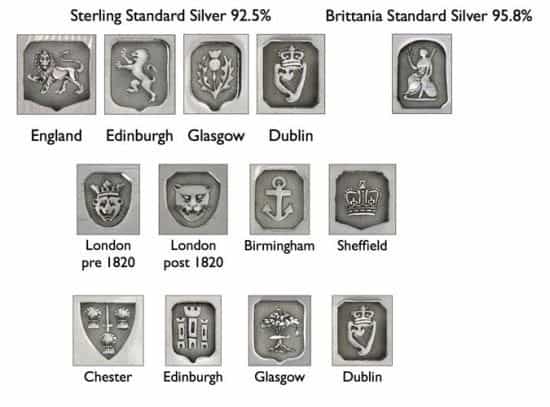
The following are the standard hallmarks used in British systems to date:
1. The Sterling Standard Mark
This mark is used to indicate how pure a silver item is.
In England, the sterling mark is a lion passant bearing the appearance of a lion. But over the years, there have been other symbols, including:
- Britannia Standard
This grading system was introduced in 1697 due to an Act of Parliament. The hallmark sign is the image of Britannia (figure of a woman).
Britannia standard was introduced to limit the melting of silver coins to make silver plate.
By increasing the grading standard for silver plates, fine silver would need to be added to raise the alloy’s purity.
Since Britannia silver is softer than sterling silver, traders raised complaints. As a result, sterling silver was reinstated as the standard grading system.
- Millesimal Fineness 958
Adjustments in hallmarking of silver led to the use of the Millesimal Fineness 958 mark. This grading system employs the Britannia symbol as an option.
Items carrying any of these symbols are 92.5% silver.
2. The Assayer’s Mark
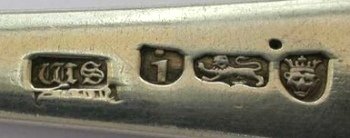
Assayers are offices charged with analyzing and grading the purity level of a precious metal.
After analyzing the purity of a metal, the assayer places an assay mark on the silver.
There have been several assay offices, but today, there are only four n the UK:
- London
All silver hallmarked in London before 1820 has a leopard’s head mark.
The tradition of hallmarking began in London. In the 1400s, artisans brought items for assaying to Goldsmith’s Hall. The goods received the King’s mark, a leopard’s head.
Post-1820, the hallmark changed to a crowned leopard’s head.
To this day, the crowned leopard head is the mark used by the London office.
- Birmingham
The hallmark for Birmingham is a sideways anchor.
The Birmingham office is the most significant worldwide, valuing other precious metals like diamond, platinum, gold, and gemstone and providing certification.
- Sheffield
From 1773, the mark for Sheffield was a crown, but this was later replaced by the Yorkshire rose.
Coincidentally, the office gained fame from a unique fuse-plating technique invented by Thomas Bolsover that came to be known as the Sheffield Plate.
- Edinburgh
Since 1975, the Edinburgh assay office mark has been a lion. Earlier on, for about a century, the mark was a thistle.
In Ireland, the current assay office is in Dublin, and its mark is a crowned harp.
3. Date Mark
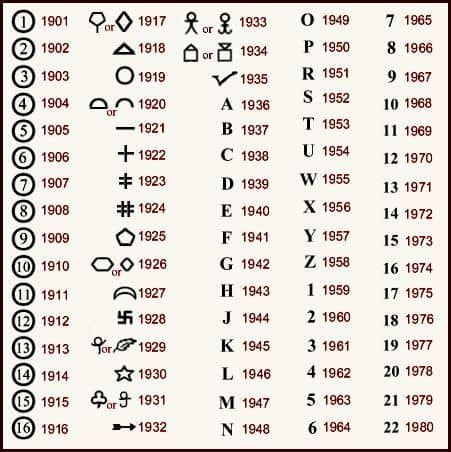
The date mark is a single letter of the alphabet that helps you determine the year a silver item was made.
To decipher an accurate date, you must consider all the details of the letter, including the typeface, whether it’s uppercase or lowercase, and even the background in which the letter is engraved.
4. City Mark
This mark indicates the city or town an item was assayed and more.
For example, from March 2018, federal law required that items assayed offshore bear a stamp that differs from those assayed in the UK.
5. Makers Mark
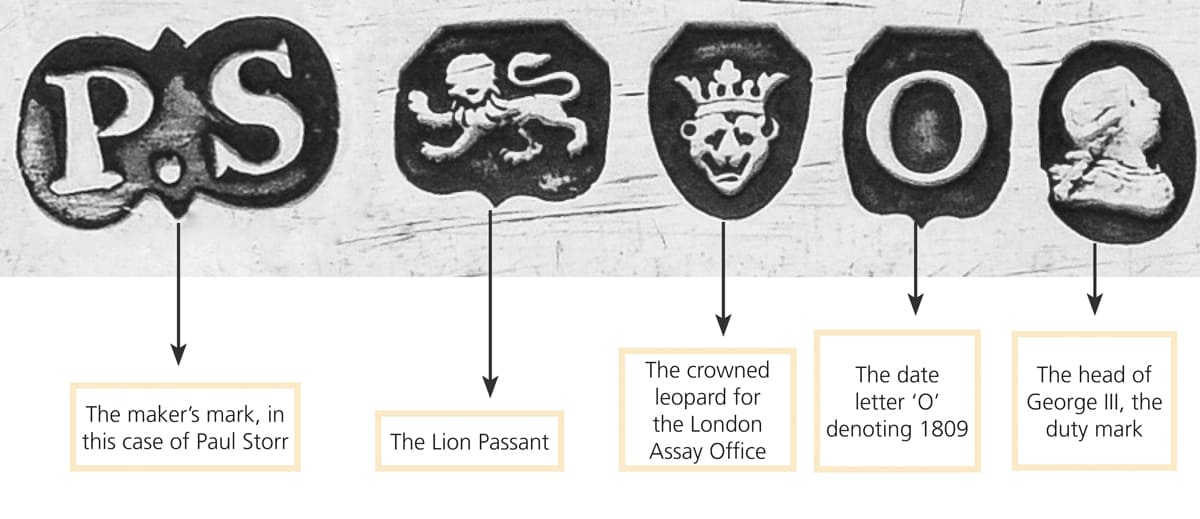
All silversmiths have a unique symbol known as a makers mark.
The symbol is usually some initials within an escutcheon (shield or emblem bearing a coat of arms). Logos are also used, but these must provide sufficient traceability.
6. Duty Mark
The duty mark was introduced to indicate that duty tax has been paid for a piece. However, this mark was discontinued in 1890.
France
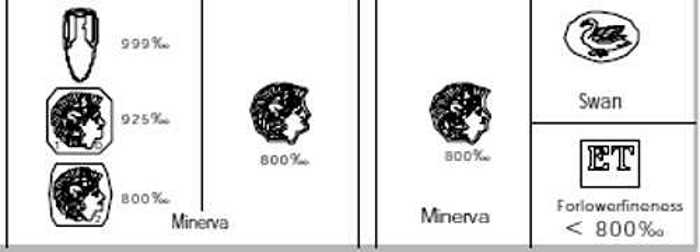
There are two standard silver grading systems in France:
- 1st standard (95% silver)
- 2nd standard (80% silver)
In France, the standard mark for both the 1st and 2nd standard silver is the goddess Minerva and the numeral 1 or 2.
They also use the maker’s mark. It consists of a lozenge shape with the manufacturer’s initials.
The US
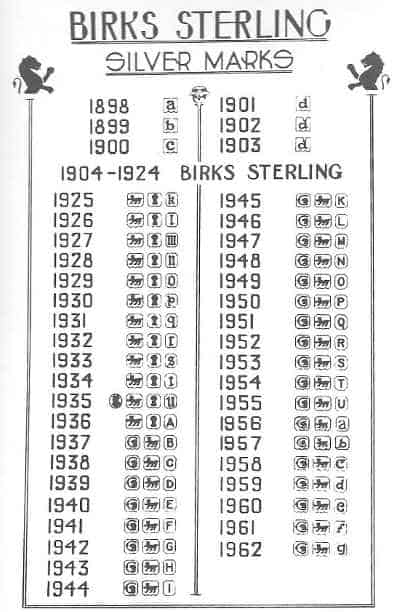
Historically, the US had no standard system of grading. But from 1814 to 1830, Baltimore had its own assay office.
In 1868, the US adopted Sterling silver 925 as their grading standard.
Prior to this, because coins in the US were made from silver, manufacturers melted these to obtain silver.
There was .750 millesimal fineness (75% silver) and .900 coin silver (90% silver). In fact, the terms “Coin” and “Pure coin” were used to mark silver.
As you can imagine, the purity level varied, prompting a need for a more standardized grading system.
Consequently, the US later adopted the Sterling silver grading standard. And from then on, pieces were marked Sterling 925.
As for the date mark, the US did not have one. But the major silver manufacturers like Tiffany and Goshen had their date marking system.
Interestingly, although the US did not have an assay, city, or date mark, manufacturers did have maker marks consisting of logos. These were often similar, prompting heated disputes.
Hungary

Hungary used the head of Diana, an ancient Greek heroine, as their hallmark symbol.
The head was encircled by a frame of concave, convex, or straight lines, which denoted the following.
- Concave line – a purity level of 140
- Straight line – a purity level of 150
- Converse line – a purity level of 160
If the frame was a hexagon shape, it symbolized 900 (90% silver).
How Do You Identify Sterling Silver Marks and Numbers?
There are many hallmarks of British silver and several books on the market to help with deciphering the marks and numbers. However, dealers and collectors worldwide use a standard reference book, Bradbury’s Book of Hallmarks.
There is also an online list and a hallmark guide, among other resources you can use. Armed with these, you can determine where, when, and by whom your silver item was made.
Here’s a step-by-step guide on how to read sterling silver hallmarks:
1. The Stamp
Locate the stamp containing the marks and numbers. On tea sets, the marking is often at the bottom of the side with a flat surface. On jewelry such as a ring or watch, you’ll find it on the inside.
The hallmark may be a little unclear. If that’s the case, you may need to rub it a little. Try moistening it with your breath and wipe gently.
Now you can start to decipher the marks and numbers.
2. The Standard Mark
Is the item silver?
The standard mark is what you use to confirm that it’s a silver piece. It’s the figure of a lion referred to as a lion passant or lion passant guardant used in sterling silver made in England.
So what’s the difference between the two lions?
While the lion passant is depicted as walking, the lion-like figure was depicted as standing or facing you in earlier times. This “standing” lion passant guardant mark is used in sterling silver manufactured in Glasgow.
Besides the walking or standing lion passant mark, the standard mark could also take the following forms:
- The crowned harp for silver that was assayed in Dublin
- The image of Britannia for Britannia standard silver
- The thistle for silver Edinburg silver.
The standard mark proves that the item meets the standard of purity (92.5% silver).
3. The Town Mark
After confirming your item is sterling silver, the next step is to identify when the piece was made. The town mark helps you figure that out.
Here are some common town marks depending on where the silver was hallmarked::
- The anchor for Birmingham
- The leopard’s head for London
- The leopard’s head crowned for London silver pre-1820
- The crown for Sheffield silver
- The castle for Edinburgh silver
- The crowned harp for Dublin silver
- The three wheat sheaves for Chester
Knowing the town mark is crucial for learning other details, as covered in the following steps below.
You can use Bradbury’s reference book to obtain this information. Alternatively, here’s a list of some common town marks.
For example, suppose your item has the sign of a crown. You would turn to the Sheffield section on our town marks as the next step.
4. The Date Letter
The date letter helps you know the year your piece was made. You’ll find it next to the town mark, in this case, the crown sign. However, note that it’s possible to find another sign next to the town mark (the duty mark). This is just to give you more details on where the item was made.
To decipher the date letter to determine the date the piece was hallmarked, you can go to the appropriate section of Bradbury’s reference book. Compare the mark you see with the matching date letter.
Alternatively, you can use a free online guide or purchase a hallmark guide.
Suppose you find two symbols representing the town mark and duty mark. So the second mark would determine the exact year of the hallmark.
5. The Maker’s Mark
The maker’s mark helps you determine the silversmith who made the item.
If your sterling silver piece originated from Sheffield in a specific year, you could find out the company that manufactured it.
Just ensure the stamp details (going by the above example, the shape of the crown) and the date of manufacture match.
Is There an App for Identifying Hallmarks?
Yes, there’s an app available for identifying silver hallmarks — Millers Silver Marks available on App Store and Google Play.
Collectors, traders, and dealers use this app to decipher marks and numbers on antique silver stamps to determine details of origin and level of purity. They can then record the data to use on catalogues.
The app provides all details, such as standard marks, makers marks, and other information on imports and exports. It’s no wonder it’s an indispensable tool for students and collectors researching silver hallmarks.
Conclusion
Now you better understand how you can identify Sterling silver marks and numbers and what each symbol represents. It’s exciting to know you can trace the origin of a silver piece, including where, when, and by who made it in minutes from the comfort of your home. Just ensure you follow all the steps outlined correctly, paying attention to the marks, symbols, and letters. You can use Bradbury’s reference book, the online list, or the hallmark guide.
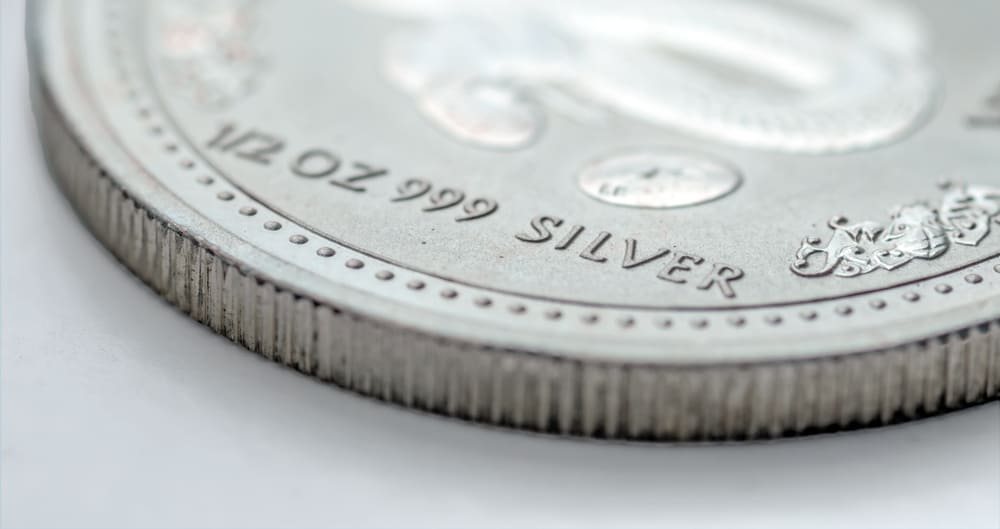
Hi, Hope all is well. Can you help me identify this silver hallmark. It appears to be that of a Flamenco Dancer with hat, holding a bouquet of flowers? Please open attachment. Thank You, Benjamin Aumenta
Wow very interesting I was aware of 999 and 9999 pure silver, it is surprising to know the first silver standard was introduced in 1907. Nowadays most refineries only go with .999 or .9999 silver purity.
I like to stack both silver bars and coins. Especially kilos and 100 oz silver bars. Some of my favorite dealers are apmex and BOLD Precious Metals for big-ounce silver bars.
I have a Kolo Hand Wrought Sterling Broach with the number 140 on it. What does the 140 mean.